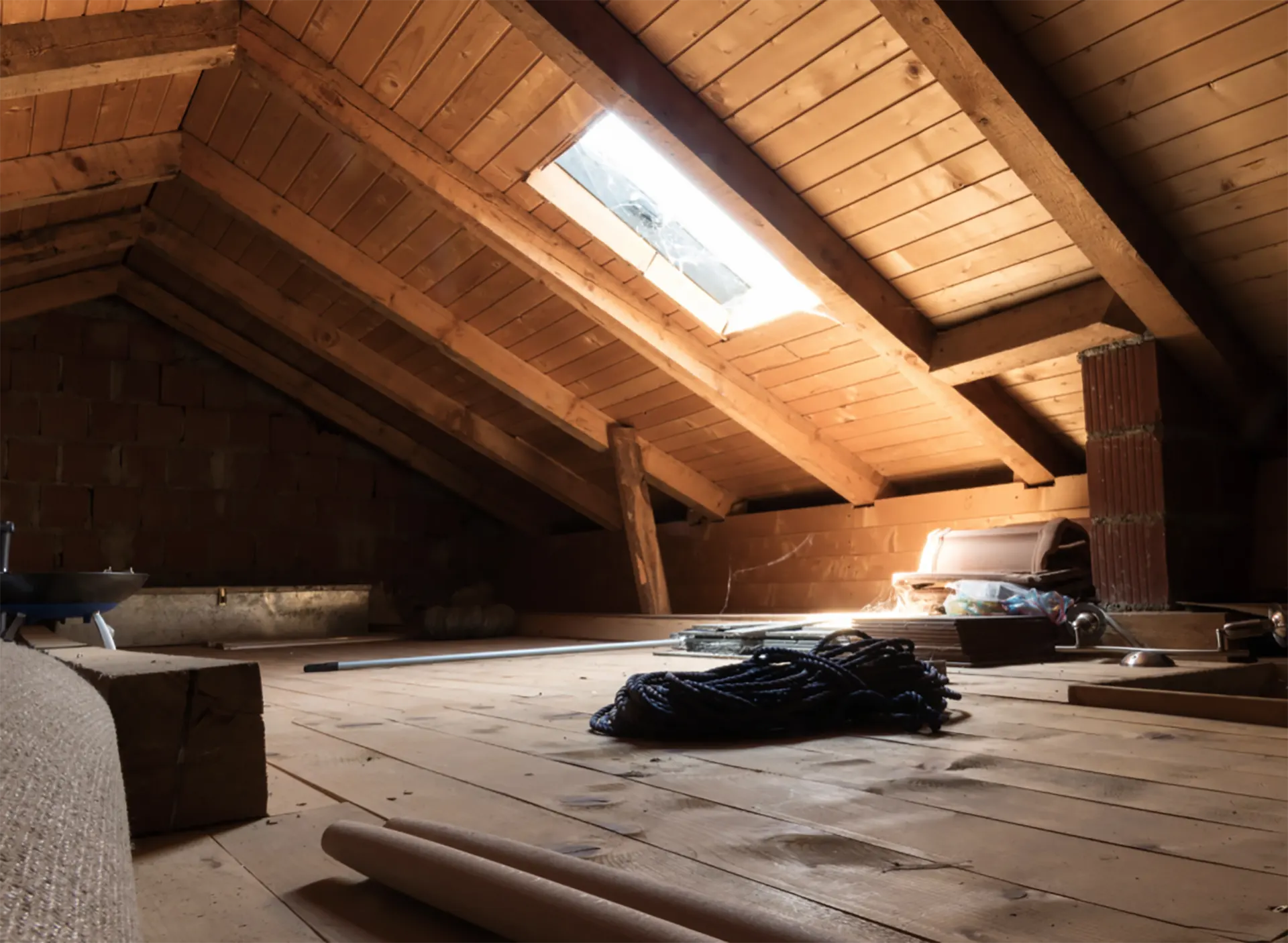If you are looking to add more living space to your house, converting your attic into an inhabited room may be a great way to do it. Attic conversions can be a cost-effective way to add square footage to your home without having to build a new addition. However, is this the right solution for you? Before you convert your attic, consider the various pros and cons.
PROS OF CONVERTING ATTIC TO ROOM
It is easy to imagine the pros of converting your attic into a proper room. Most people will welcome the extra living space this provides. You can turn it into a bedroom, home office, or playroom for the kids. Attic conversions can also provide extra storage space for your home. You can install built-in storage solutions to help keep clutter at bay and keep your living space organized. The possibilities are endless.
Converting your attic into a functional room can also increase the value of your home. If you plan to sell your house in the future, the additional living space can make your property more attractive to potential buyers.
In addition, it may not have to be an expensive solution. Converting an attic into a room can be more cost-effective than building an addition. Since the structure is already there, you don’t have to spend as much money on building materials and labor.
Finally, you have a lot of creative freedom to design the space however you want. You can add windows to bring in natural light, install new flooring, and even add a staircase to access the new living space.
CONS OF CONVERTING ATTIC TO ROOM
While the pros seem obvious, what about the cons? Okay, there are not so many cons as much as things to consider before starting work.
First of all, converting your attic into a living space must meet local building codes and regulations. This means you may need to hire an engineer to ensure the structural integrity of the space.
You may also need to work on your home’s electrical and HVAC infrastructure. Attics can get hot in the summer and cold in the winter, which means you may need to add a heating and cooling system to the new living space. This can be costly and require additional planning, since electrical and HVAC systems require permits and inspections.
Insulation and ventilation are another concern. Attics are typically not designed to be living spaces, which means they might not have adequate insulation and ventilation. Adding insulation and ventilation come at an extra cost, but are essential to ensure the new living space is comfortable and safe.
Also, attics can have limited ceiling height, especially if there are rafters or trusses. This can make the space feel cramped and uncomfortable, potentially making them unsuitable for taller individuals.
One more thing to consider is access to your new room. If your attic has no staircase, you need to install one. Unfortunately, adding a staircase to your attic conversion can be challenging, especially if you don’t have enough space on the lower level of your home. You may need to sacrifice square footage in another room to create access to the new living space.
TIPS FOR CONVERTING AN ATTIC TO A ROOM
If you have considered the pros and cons and are ready to go ahead with converting your attic into a living space, here are some tips to help make the project go smoothly:
- Check Building Codes
Make sure to check your local building codes and regulations before you begin the project. Since you may need permits and inspections, it’s important to stay on top of the requirements.
- Plan Ahead
Planning is crucial when converting an attic into a living space. Make sure to create a detailed plan that includes the layout, materials, and budget.
- Insulation and Ventilation
Make sure to add adequate insulation and ventilation to the new living space to ensure it’s comfortable and safe.
- Hire a Contractor
If you’re not experienced with home improvement projects, consider hiring a contractor to handle the conversion. They can ensure the project meets local building codes and regulations and provide guidance throughout the process.
- Add Windows
Since many attics are rather cramped, adding windows can help convert them into an airy, pleasant space.
CONSIDERATION BEFORE STARTING YOUR ATTIC CONVERSION
When it comes to converting your attic into a functional living space, one of the most crucial considerations is the structural assessment. Your attic’s structure will determine whether it can be safely transformed into a bedroom or other usable space. Here are the key factors to keep in mind:
- Inspecting the Roof and Support Structure
Before diving into your attic conversion project, it’s essential to inspect the roof and support structure. Look for signs of wear and tear, water damage, or structural issues. You have to check for leaks, damaged shingles, or sagging areas in the roof. Any issues with the roof need to be addressed before converting the attic. Also, examine the condition of support beams and trusses. Ensure they are in good shape and capable of bearing the additional load of a bedroom. Assess the foundation of your home, as it plays a role in supporting the attic. Any foundation issues should be resolved to ensure stability.
Engaging a professional structural engineer or contractor is advisable at this stage. They can provide a detailed assessment and recommend necessary repairs or reinforcements to make your attic conversion safe and structurally sound.
- Adequate Insulation and Ventilation
Proper insulation and ventilation are vital for the comfort and energy efficiency of your attic bedroom. You should evaluate the existing insulation in your attic. Insufficient insulation can lead to temperature extremes, making your new bedroom uncomfortable. Upgrading insulation can help maintain a comfortable temperature year-round. It is also very important to сheck for the presence of vents and ensure they are functioning correctly. Inadequate ventilation can result in mold and moisture problems.
Consider consulting an HVAC specialist to assess your attic’s heating and cooling needs. They can help you choose the right insulation and ventilation solutions to create a comfortable and energy-efficient space.
HOW TO TURN AN ATTIC INTO LIVING SPACE
When embarking on turning an attic into a room, it’s essential to start with proper attic cleaning and preparation. It lays the foundation for a successful project.
- Begin by decluttering your attic space. Remove any items that are no longer needed or have outlived their usefulness. This step not only frees up space but also allows you to assess the condition of the attic. Use caution when handling attic clutter, as it may contain hidden hazards. Wear appropriate protective gear and dispose of items responsibly.

- Examine the condition of your attic’s insulation. Look for signs of damage, wear, or settling. Inadequate insulation can lead to energy loss and temperature fluctuations. You may want to consider upgrading your attic insulation. Improved insulation can enhance energy efficiency and comfort in your home.
- The ceiling and walls of your attic play a crucial role in maintaining a comfortable and functional space. Here’s what to consider:
- Inspect the attic ceiling for signs of water damage or leaks from the roof. Address any issues promptly to prevent further damage.
- Decide on the type of wall finishes you want for your attic. Options include drywall, paneling, or exposed brick, depending on your design preferences.
- Choose paint colors that complement the attic’s overall theme. Lighter colors can make the space feel more open and airy, while darker colors can add warmth and coziness.
- Creating a functional attic space often involves installing attic flooring. Here are important points:
- select a flooring material that suits your needs and budget. Common options include plywood, OSB (oriented strand board), or attic flooring panels designed for easy installation.
- if your attic is not heated or insulated, consider adding insulation beneath the flooring to improve energy efficiency.
- follow proper installation guidelines to ensure the attic flooring is sturdy and safe for walking. It’s essential to distribute weight evenly.
CONSIDER YOUR GOALS AND BUDGET
Converting an attic into a living space can be a great way to add extra square footage to your home and increase its value. However, it is important to carefully consider the pros and cons of such a project before beginning.
As we saw, some of the key advantages of converting an attic include creating additional living space, adding natural light, and potentially increasing the value of your home. On the other hand, some of the potential disadvantages include the need to meet local building codes, the cost and complexity of the project, and the potential for lower ceiling heights or limited access.
Thus, before starting an attic conversion project, homeowners should carefully consider their goals and budget, as well as the potential impact on their home’s structure and systems.
Consult with a contractor or engineer to ensure that the project is feasible and meets all necessary codes and requirements. With careful planning and execution, converting an attic into a living space can be a rewarding home improvement project that adds value and functionality to your home.
Call Pure Eco Inc. today at (877) 870-7998 to request your free Home Comfort Estimate and learn how to convert your attic to a spacious room you will love!





